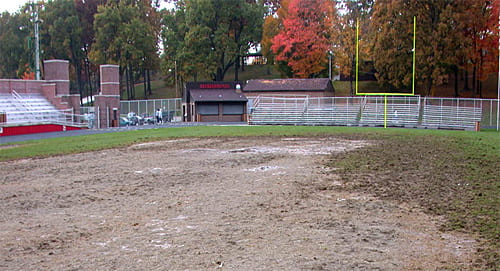Whose fields are these anyway? Working towards a common goal

Athletic Directors and Coaches can work with and support their Field Manager on providing good quality playing fields by learning:
- How overuse of fields (image) especially under very wet or very dry conditions can injure turf density which is necessary for athlete performance (traction and footing) and safety.
- About Best Management Practices necessary to provide safe, functional fields.
- That field use needs to be based on current field conditions and less on planned schedules.
Impact of overuse on field quality and safety
| Stakeholder | Perspective | High demand or Overused Fields | Results in |
|---|---|---|---|
| Athletic Directors Coaches Players Field users |
|
|
|
| Grounds Manager |
|
|
|
Focus on Best Management Practices (BMPs)
Resources, budget, labor and time, all influence the level of field care that can be provided. However, implementing essential Best Management Practices that improve field conditions and increase turf density will provide greater player safety and allow for more field use.
| Practice | Results depend on | Necessary Investment |
|---|---|---|
| Mowing | Correct height of cut and frequency | Select equipment that can get the job done efficiently |
| Watering | Timely supplemental application at the correct rate and with efficient coverage | Functioning below ground system or above ground system that can water fields efficiently. System needs to be checked for accuracy. |
| Fertilizing | Applied properly at the correct time and rate | Have a nutrient analysis done for each field. Use soil test results to develop fertilizer program. Select fertilizer based on soil conditions and available resources. |
| Aerifying | Matching operation with goal determines frequency and timing | Minimum 2 times per year, 4-6 times better In season: solid tine, off season other options |
| Overseeding | Always using good quality seed throughout the season | Use recommended varieties Focus regularly on high-use areas |
| Topdressing | Selecting and applying the correct material for the purpose of the application | Use for minor variations or depressions, better seeding, amending soils (budget permitting) |
Providing a good quality playing field requires the field manager to:
- Know the general Best Management Practices and be able to provide basic “Duty of Care.” The video Safety First featuring Cornell turfgrass Extension specialist Frank Rossi outlines practices of reasonable field care.
- Be aware of the characteristics of the individual field to make field use decisions on a daily basis.
- Adjust the management program given expectations, use and impact of weather (heavy rainfall) within budget and labor resources.
Management schedules have been developed based on high, medium and minimal management resources. Effective field managers use these schedules as a guide for routine operations but have experience to make adjustments given current field conditions, expected use and pending weather events.
Building stronger relationships:
Athletic Directors and Coaches can help build a better relationship with the Field Manager by:
- Learning and acknowledging their Field Manager’s knowledge, experience and commitment to providing safe, functional fields.
- Trusting the recommendations of the Field Manager about field conditions.
- Fostering mutual respect.
- Helping to develop a communication system that promotes shared decision-making when it comes to proper use of a field and closing a field.
Work together on field use policies
Suggestions from a successful Director of Facilities:
“All stakeholders at some point need to be involved in developing a field use policy. It all starts with the Head Groundskeeper, Facility Director and Athletic Director. Then the plan needs to have “buy-in” from everyone from the Board of Ed, to the Superintendent, AD, Coaches and student athletes”. Once stakeholders understand that fields are not arbitrarily shut down but decisions are based on science, management will be easier”.
With cooperation from and backing by all interested parties (players, coaches, Athletic Directors, parents, community members, administrators) and reasonable expectations, experienced staff can implement BMP when provided necessary products and equipment.


